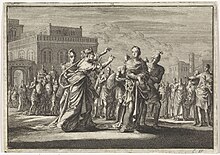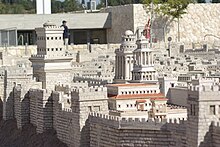Mariamne I
This article includes a list of general references, but it lacks sufficient corresponding inline citations. (November 2013) |
| Mariamne I | |
|---|---|
Promptuarii Iconum Insigniorum | |
| Died | 29 BCE |
| Spouse | Herod the Great |
| Issue | Alexander Aristobulus IV Salampsio Cypros |
| House | Hasmonean |
| Father | Alexander of Judaea |
| Mother | Alexandra the Maccabee |
Mariamne I (d. 29 BCE), also called Mariamne the Hasmonean, was a
Her name is spelled Μαριάμη (Mariame) by Josephus, but in some editions of his work the second m is doubled (Mariamme). In later copies of those editions the spelling was dissimilated to its now most common form, Mariamne. In Hebrew, Mariamne is known as מִרְיָם, (Miriam), as in the traditional, Biblical name (see Miriam, the sister of Moses and Aaron).
Life

Mariamne was the daughter of the Hasmonean
Her mother,
Because of this conflict between Mariamne and Salome, when Herod visited
Children
- son Alexander, executed 7 BCE
- son Aristobulus IV, executed 7 BCE
- daughter Salampsio
- daughter Cypros
Talmudic reference

There is a Talmudic passage concerning the marriage and death of Mariamne, although her name is not mentioned. When the whole house of the Hasmoneans had been rooted out, she killed herself by throwing herself off a roof. She committed suicide because Herod had spared her life, so that he could marry her. If he were to marry her, then he would be able to claim that he was not actually a slave, but rather that he had royal blood.[3] Out of love for her, Herod is said to have kept her body preserved in honey for seven years. There is an opinion that he would use her to fulfill animalistic desires.[4] In the Talmud this sort of action is called a "deed of Herod".[5] Josephus relates also that after her death Herod tried in hunting and banqueting to forget his loss, but that even his strong nature succumbed and he fell ill in Samaria, where he had made Mariamne his wife.[6] The Mariamne Tower in Jerusalem, built by Herod, was without doubt named after her; it was called also "Queen".[7]
Mariamne in the arts

She is remembered in De Mulieribus Claris, a collection of biographies of historical and mythological women by the Florentine author Giovanni Boccaccio, composed in 1361–62. It is notable as the first collection devoted exclusively to biographies of women in Western literature.[8] From the Renaissance to contemporary times, there has been a long tradition of works of art (dramas, operas, novels, etc.) devoted to Mariamne and her relationship with Herod the Great.[9] The list includes:
- Marianna (1565), an Italian drama by Lodovico Dolce
- Elizabeth Tanfield Cary
- Herod and Antipater, with the Death of Faire Mariam (1622), an English drama by Gervase Markham and William Sampson
- Mariamne (1636), a French drama by François Tristan l'Hermite
- El mayor monstruo los celos (1637) a Spanish drama by Pedro Calderon de la Barca
- La mort des enfants d’Hérode; ou, Suite de Mariamne (1639), a French drama by Gathier de Costes de la Calprenède
- Herod and Mariamne (1673), an English drama by Samuel Pordage
- Herodes en Mariamne (1685), a Dutch translation of Tristan l'Hermit's play by Katharina Lescailje
- La Mariamne (1696), an Italian opera by Giovanni Maria Ruggeri (mus.) and Lorenzo Burlini(libr.)
- Mariamne (1723), an English drama by Elijah Fenton
- Mariamne (1723), a French drama by Voltaire
- Mariamne (1725), a French drama by Augustin Nadal
- La Marianna (1785), an Italian ballet by Giuseppe Banti (chor.)
- Marianne (1796), a French opera by Nicolas Dalayrac (mus.) and Benoît-Joseph Marsollier (libr.)
- "Herod’s Lament for Mariamne" (1815), an English song by George Byron(libr.)
- Erode; ossia, Marianna (1825), Italian opera by Saverio Mercadante (mus.) and Luigi Ricciuti (libr.)
- Herodes und Mariamne (1850), a German drama by Christian Friedrich Hebbel
- Mariamne Leaving the Judgment Seat of Herod (1887), a painting by John William Waterhouse
- "Herod and Mariamne" (1888), an English poem by Amelie Rives
- Myriam ha-Hashmonayith (1891), a Yiddish drama by Moses Seiffert
- Tsar Irod I tsaritsa Mariamna (1893), a Russian drama by Dmitri Alexandrov
- "Mariamne" (1911), an English poem by Thomas Sturge Moore
- Herodes und Mariamne (1922), incidental music by Karol Rathaus
- Lied der Mariamne (ohne Worte) (1927), incidental music by Mikhail Gnesin
- En Idealist (1929), a Danish drama by Kaj Munk
- Hordos u-Miryam (1935), a Hebrew novel by Aaron Orinowsky
- Herod and Mariamne (1938), an English drama by Clemence Dane
- Mariamne (1967), a Swedish novel by Pär Lagerkvist
- The Black Rose (novel) by Thomas B. Costain makes comparison of the titular character toMaiamne in reference to her renowned beauty and their shared name.
See also
- 1 Maccabees and 2 Maccabees for the family history.
- Hasmonean Kingdomfor the history the Hasmonean dynasty.
- Mariamne for the derivation of her name.
Notes
- Antipater IIIand with him during his trial before Varus in 5 BCE. See Antiquities, Book XVII, Chapter 5:2
- ^ Josephus, Jewish Antiquities 15.7.4–6.
- ^ B. B. 3b
- ^ Ib.; S. Geiger, in "Oẓar Neḥmad", iii. 1
- ^ Sanh. 66b
- ^ "Ant." xv. 7, § 7
- ^ Βασιλίς "B. J." ii. 17, § 8; v. 4, § 3
- ISBN 0-674-01130-9.
- ^ G. Boccaccini, Portraits of Middle Judaism in Scholarship and Arts (Turin: Zamorani 1992); M. J. Valency, The Tragedies of Herod and Mariamne (New York 1940).
Kiddushin 70 B
References
- Josephus. Jewish War1.241, 262, 431–444.
 This article incorporates text from a publication now in the public domain: Richard Gottheil; Samuel Krauss (1901–1906). "Mariamne". In Singer, Isidore; et al. (eds.). The Jewish Encyclopedia. New York: Funk & Wagnalls.
This article incorporates text from a publication now in the public domain: Richard Gottheil; Samuel Krauss (1901–1906). "Mariamne". In Singer, Isidore; et al. (eds.). The Jewish Encyclopedia. New York: Funk & Wagnalls.- Gabriele Boccaccini (1992). Portraits of Middle Judaism in Scholarship and Arts. Turin: Zamorani. ISBN 9788871580210.
- Maurice J. Valency (1940). The Tragedies of Herod and Mariamne. New York: Columbia University Press.
External links
- Mariamne entry in historical sourcebook by Mahlon H. Smith
- Mariamne entry in Jewish Encyclopedia by Richard Gottheil and Samuel Krauss
- Kittymunson.com, the Hasmonean Maccabeus Mariamne family tree
